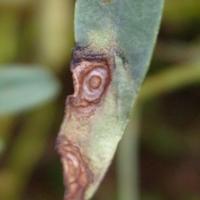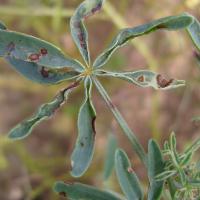Diagnosing grey leaf spot in broadleafed crops
A fungal disease (Stemphylium sp.) that is most damaging in wet spring conditions.
What to look for
- Widespread plant defoliation following warm wet weather.
Paddock
- Dark-brown circular lesions that can appear on leaves and then progress to ash-brown necrosis.
- In severe cases plants lose all their leaves.
- Brown pockmark lesions on stems and pods.
Plant
What else could it be
| Condition | Similarities | Differences |
|---|---|---|
| Diagnosing brown spot in narrow-leafed lupins | Dark spots on leaflets | Solid dark grey spots without ash-grey leaf necrosis |
| Diagnosing cladosporium leaf spot in narrow-leafed lupins | Dark spots on leaflets | Lesions are solid dark grey spots, not circular and light grey, and it is more restricted to moist situations. |
Where did it come from?

Contaminated stubble
- Disease incoculum is carried on infected stubble.
- The disease was first recorded in Western Australia in 1972 and affected nearly all varieties during the 1970. All lupin varieties released since 1979 are believed to carry genes for resistance to grey leaf spot.
Management strategies

Resistant varieties
- Not economically damaging. No control measures recommended.
- Varieties differ in susceptibility.
See also
Where to go for expert help
Page last updated: Friday, 17 April 2015 - 9:10am




